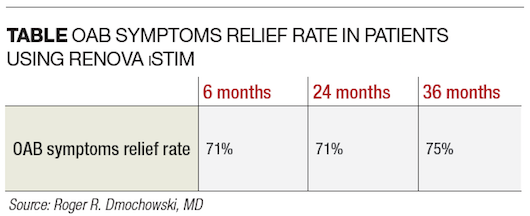Article
Tibial stimulation device demonstrates sustained OAB symptom relief
Author(s):
The first long-term study of an implantable electrode for tibial stimulation to treat overactive bladder shows a sustained high responder rate and a clean safety profile, said Roger R. Dmochowski, MD, at the AUA annual meeting in Chicago.
Chicago-The first long-term study of an implantable electrode for tibial stimulation to treat overactive bladder (OAB) shows a sustained high responder rate and a clean safety profile, said Roger R. Dmochowski, MD, at the AUA annual meeting in Chicago.
Three-year data show that 75% of patients are responders, with an 80% response rate in patients with large leaks.

“No technical failures were encountered at 3 years. This does appear to be a good platform for the purpose of the long-term management of OAB. The implantation procedure is simple and safe. It is designed to be patient-centric and has a good home use profile,” said Dr. Dmochowski, director, Pelvic Medicine and Reconstruction fellowship, Vanderbilt University, Nashville, TN.
He reported data from 20 patients of 36 who were enrolled in a pilot study of the wireless neurostimulator (RENOVA iStim).
Implanted near the tibial nerve, the device electrically stimulates the tibial nerve, modulating neuronal signals to the bladder, urinary sphincter, and pelvic floor.
Also see: OAB treatment efficacy similar in frail, nonfrail patients
“The patient wears a power stimulator around the ankle for a variable period of time on a daily basis. That device has closed loop radiofrequency energy and data transfer capabilities, so power comes through it to the receiver in the implant. We can also determine patient compliance as well as interact with the patient based upon the patient’s response. There is a clinician programmer associated with the wearable device that functions via Bluetooth,” Dr. Dmochowski said.
The initial pilot study enrolled 36 patients, 88% of whom were women. Mean age was 54.1 years. At baseline, the mean number of voids was 12 and the mean number of leaks was 6.6. More than 70% of the 34 patients who completed the study experienced clinical improvement at the predefined 6-month follow-up.
The extended cohort included 20 with baseline characteristics similar to those of the overall study cohort, followed up to a total of 3 years (mean duration: 34 months). OAB symptom relief was defined as the proportion of patients with ≥50% reduction in urgency urinary episodes or urgency urinary incontinence or normalization of the number of voids (<8/day).
Per protocol OAB symptoms relief was experienced by 71% at 6 months, 71% at 24 months, and 75% at 36 months. On an intent-to-treat basis, 70% experienced OAB symptoms relief at 6 months and 75% at last observation carried forward.
Clinical success on urgency urinary incontinence (UUI) episodes was analyzed separately for ≥50% reduction in the number of leaks and ≥50% reduction in the number of large leaks. In the 29 patients with wet OAB, on a per protocol analysis, 52% had a ≥50% reduction in the number of leaks and 85% had a ≥50% reduction in the number of large leaks at 6 months.
Next: Large leaks respond better than small leaksLarge leaks respond better than small leaks
In the 12 patients with 36-month follow-up, reductions of ≥50% in the number of leaks and large leaks were achieved by 58% and 75%, respectively. Rates of clinical success on UUI were similar on an intent-to-treat analysis.
Read: How four generations of physicians can work together
“It’s interesting that the large leaks appeared to respond better than the small leaks. We posit from this mixed population that incontinent patients potentially have a small degree of stress, and it appears that the benefit is being ascertained at the level of large leaks, for the urge episodes, but the patient may still reflect some stress symptoms, and that’s why the [reduction in the number of] overall leaks is less robust,” Dr. Dmochowski said.

The improvement in health-related quality of life (HRQL) was durable as well, with a statistically significant improvement (p<.05) in HRQL and symptoms maintained throughout the 36 months of follow-up. The improvements in HRQL and all of its subscales were greater than the minimal important difference (>10 points).
At 36 months, 11 of 15 (73.3%) patients reported to be very satisfied with their treatment, three (20%) were moderately satisfied, and one (6%) was slightly satisfied.
One explantation was required during the initial pilot phase due to wound complications. There were no long-term surgical revisions or failures.
Optimal delivery of neurostimulation is still a work in progress, said Dr. Dmochowski. Patients used the device for 30 minutes, 3-6 times/week during the pilot study but were permitted to modify use during the extension study.
BlueWind Medical Ltd. funded the study.





